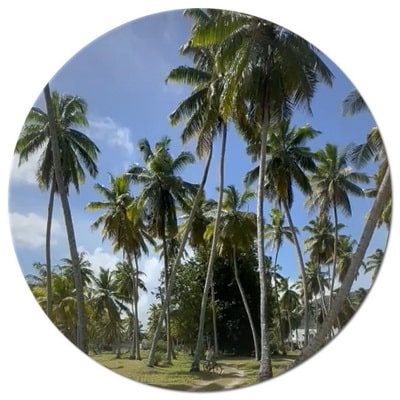How many palm trees are there in Qatar?
Yes, there are palm trees in Qatar. Despite being a desert country, Qatar has various species of palm trees that are well-adapted to the arid climate. Date palm trees, in particular, are commonly found in Qatar and have been traditionally cultivated for their valuable fruit, dates. These palm trees are often seen in urban landscapes, parks, gardens, and even some rural areas throughout the country. The palm trees not only provide shade but also contribute to the aesthetic beauty of Qatar’s environment.
Palm trees in Qatar:

In Qatar, the most common type of palm tree that grows is the date palm (Phoenix dactylifera). Date palms are well-suited to the desert climate and are cultivated for their delicious and nutritious fruit, dates. The date palm is an iconic tree in Qatar and holds cultural and historical significance in the region. These palm trees have long, slender trunks with large, feathery leaves and can reach heights of up to 20 meters or more. The date palm’s ability to tolerate high temperatures and arid conditions makes it a suitable species for growth in Qatar’s desert environment.
How many types of palm trees are there in Qatar?
There are over 2,500 known species of palm trees (Arecaceae family) found around the world. These palm tree species vary in terms of their size, shape, leaf structure, growth requirements, and appearance. Some of the most common types of palm trees include:
- Date Palm (Phoenix dactylifera)
- Coconut Palm (Cocos nucifera)
- Fan Palm (Livistona)
- Queen Palm (Syagrus romanzoffiana)
- Canary Island Date Palm (Phoenix canariensis)
- Areca Palm (Dypsis lutescens)
- Sago Palm (Cycas revoluta)
- Royal Palm (Roystonea spp.)
- Bismarck Palm (Bismarckia nobilis)
- Palmetto Palm (Sabal palmetto)
These are just a few examples, and there are many more palm tree species with distinct characteristics and distributions. The specific types of palm trees found in a particular region can depend on factors such as climate, geography, and local plant preferences.
Pruning palm trees in Qatar
Pruning palm trees in Qatar is an important aspect of their care and maintenance. Pruning helps promote the health, aesthetics, and safety of the palm trees. Here are some general guidelines for pruning palm trees in Qatar:

- Timing: It is best to prune palm trees during the cooler months, such as late winter or early spring, in Qatar. This helps minimize stress on the trees during the hot summer months.
- Dead Fronds: Remove any dead, brown, or yellow fronds (leaves) from the palm tree. These fronds can be pruned at any time of the year. They should be cut as close to the trunk as possible without damaging the trunk itself.
- Green Fronds: Avoid excessive pruning of healthy, green fronds. Pruning too many green fronds can weaken the palm tree and hinder its growth.
- Skirting: Some palm tree species have a skirt of dead or dried fronds that can be trimmed. However, be cautious not to remove too many green fronds near the top of the tree, as they are essential for the palm’s health.
- Pruning Tools: Use sharp, sterile pruning tools, such as pruning shears or a pruning saw, to make clean cuts. This reduces the risk of introducing infections or diseases to the tree.
- Safety Measures: When pruning tall palm trees, it is advisable to hire a professional tree service with the necessary equipment and expertise to ensure safety.
It’s important to note that specific palm tree species may have different pruning requirements or preferences. Therefore, it is recommended to consult with local horticulture experts or arborists in Qatar for guidance tailored to the specific palm tree species you have or encounter.
Palm tree prices in Qatar
The price of palm trees in Qatar can vary depending on several factors such as the species, size, age, and overall condition of the tree. It’s important to note that providing specific and up-to-date pricing information is challenging as prices can fluctuate and are subject to market demand and availability. Additionally, prices may vary among different nurseries, suppliers, or landscaping services in Qatar.
To get an accurate idea of palm tree prices in Qatar, I recommend reaching out to local nurseries, garden centers, or landscaping companies that specialize in palm trees. They can provide you with current pricing information and help you select palm trees that suit your requirements and budget.
It’s also worth considering that larger or more mature palm trees are generally more expensive compared to smaller or younger ones. Additionally, transportation and planting costs may be additional factors to consider when budgeting for palm trees in Qatar.
Contacting local experts or conducting research within Qatar’s specific market will provide you with the most accurate and relevant information regarding palm tree prices in the region.
Palm tree care in Qatar
Proper care is essential to ensure the health and vitality of palm trees. Here are some general guidelines for palm tree care:

- Watering: Palm trees require regular watering, especially during the establishment phase. Provide deep and thorough irrigation to reach the root zone. Watering frequency will depend on factors like climate, soil type, and palm species. Avoid overwatering, as it can lead to root rot.
- Fertilization: Palm trees benefit from regular fertilization to maintain their nutritional needs. Use a slow-release palm fertilizer or a balanced fertilizer specifically formulated for palm trees. Follow the manufacturer’s instructions for application rates and timing.
- Pruning: Remove dead, brown, or yellow fronds (leaves) regularly to keep the palm tree aesthetically pleasing and to prevent potential hazards. Avoid removing too many green fronds, as they contribute to the tree’s overall health and growth.
- Pest and Disease Control: Monitor palm trees for signs of pests, such as palm weevils or scale insects. Promptly address any pest infestations with appropriate treatments recommended by a professional arborist or horticulturist. Similarly, take preventive measures against diseases common to palm trees, such as fungal infections or bud rot.
- Mulching: Apply a layer of organic mulch around the base of the palm tree, but keep it away from the trunk. Mulch helps retain soil moisture, regulate temperature, and suppress weed growth.
- Protection from Extreme Temperatures: Palms are susceptible to cold damage in some regions. If you live in an area with occasional frost or cold temperatures, consider protecting your palm tree during winter by covering it or providing additional insulation.
- Professional Consultation: If you have specific concerns about the care or health of your palm tree, consider consulting with a local arborist, horticulturist, or nursery specializing in palm trees. They can provide personalized advice based on your palm tree species, local climate, and soil conditions.
Remember that care practices can vary depending on the species of palm tree, local climate, and environmental conditions. It’s beneficial to research and understand the specific care requirements for the type of palm tree you have or plan to plant. Can palm trees grow in Qatar? Palm care in Qatar >>





